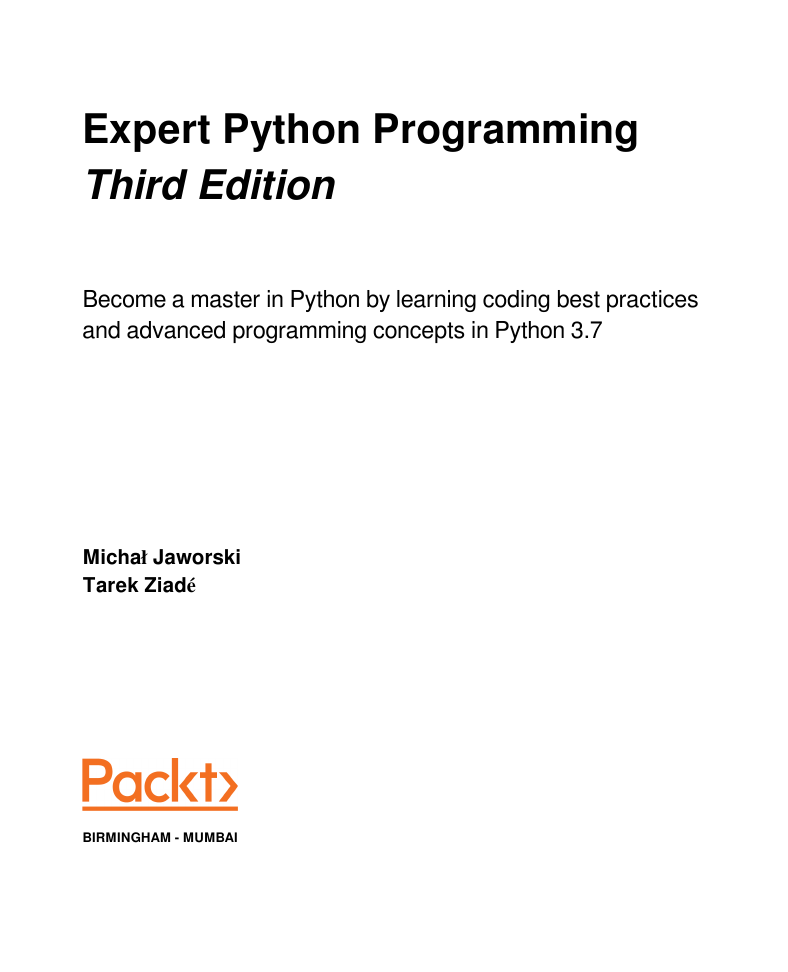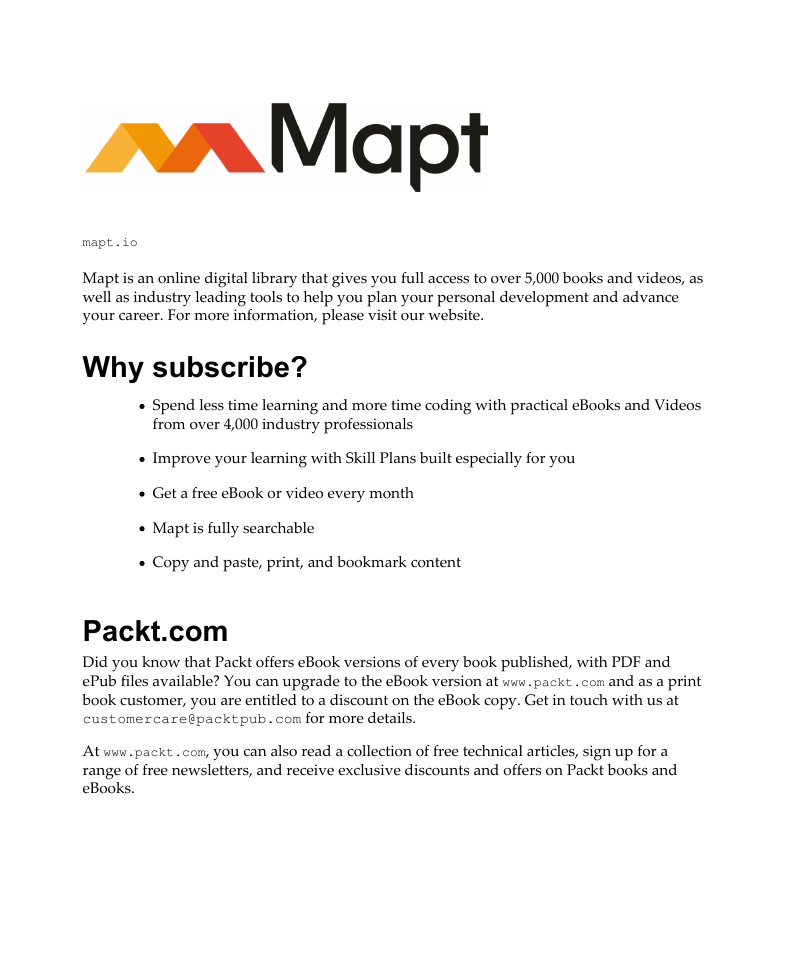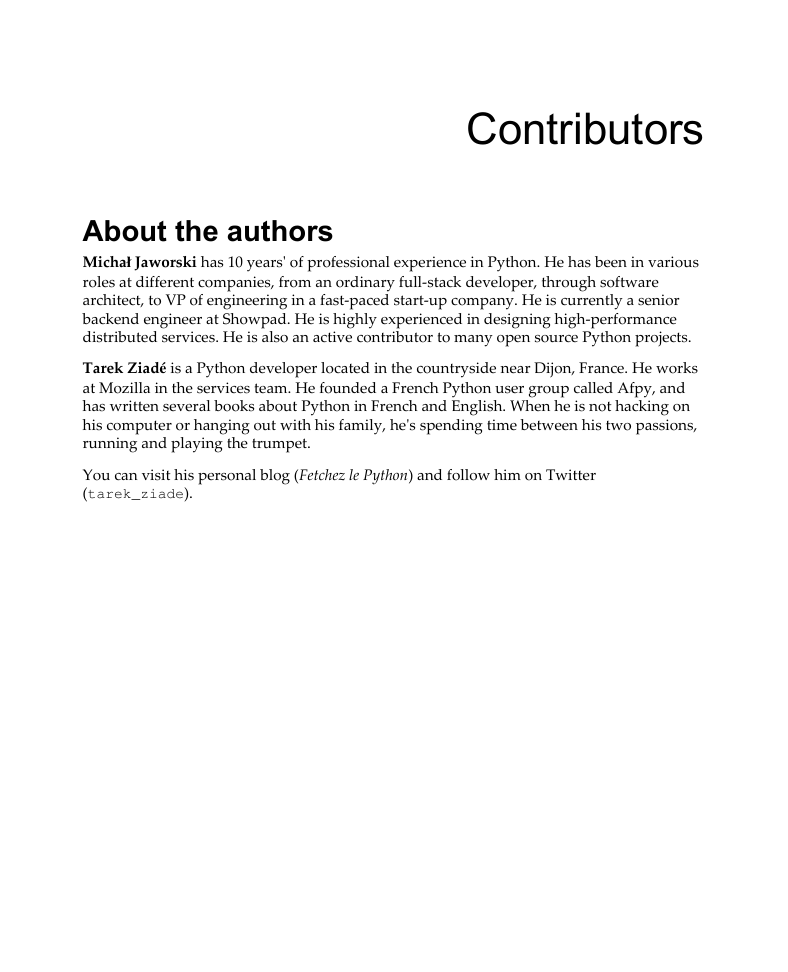Cover
Title Page
Copyright and Credits
Dedication
About Packt
Contributors
Table of Contents
Preface
Section 1: Before You Start
Chapter 1: Current Status of Python
Technical requirements
Where are we now and where we are going to?
Why and how Python changes
Being up-to-date with changes by following PEP documents
Python 3 adoption at the time of writing this book
The main differences between Python 3 and Python 2
Why should I care?
The main syntax differences and common pitfalls
Syntax changes
Changes in the standard library
Changes in data types and collections and string literals
The popular tools and techniques used for maintaining cross-version compatibility
Not only CPython
Why should I care?
Stackless Python
Jython
IronPython
PyPy
MicroPython
Useful resources
Summary
Chapter 2: Modern Python Development Environments
Technical requirements
Installing additional Python packages using pip
Isolating the runtime environment
Application-level isolation versus system-level isolation
Python's venv
venv versus virtualenv
System-level environment isolation
Virtual development environments using Vagrant
Virtual environments using Docker
Containerization versus virtualization
Writing your first Dockerfile
Running containers
Setting up complex environments
Useful Docker recipes for Python
Reducing the size of containers
Addressing services inside of a Compose environment
Communicating between multiple Compose environments
Popular productivity tools
Custom Python shells – ipython, bpython, ptpython, and so on
Setting up the PYTHONSTARTUP environment variable
IPython
bpython
ptpython
Incorporating shells in your own scripts and programs
Interactive debuggers
Summary
Section 2: Python Craftsmanship
Chapter 3: Modern Syntax Elements - Below the Class Level
Technical requirements
Python's built-in types
Strings and bytes
Implementation details
String concatenation
Constant folding, the peephole optimizer, and the AST optimizer
String formatting with f-strings
Containers
Lists and tuples
Implementation details
List comprehensions
Other idioms
Dictionaries
Implementation details
Weaknesses and alternatives
Sets
Implementation details
Supplemental data types and containers
Specialized data containers from the collections module
Symbolic enumeration with the enum module
Advanced syntax
Iterators
Generators and yield statements
Decorators
General syntax and possible implementations
As a function
As a class
Parametrizing decorators
Introspection preserving decorators
Usage and useful examples
Argument checking
Caching
Proxy
Context provider
Context managers – the with statement
The general syntax and possible implementations
As a class
As a function – the contextlib module
Functional-style features of Python
What is functional programming?
Lambda functions
map(), filter(), and reduce()
Partial objects and partial() functions
Generator expressions
Function and variable annotations
The general syntax
The possible uses
Static type checking with mypy
Other syntax elements you may not know of yet
The for ... else ... statement
Keyword-only arguments
Summary
Chapter 4: Modern Syntax Elements - Above the Class Level
Technical requirements
The protocols of the Python language – dunder methods and attributes
Reducing boilerplate with data classes
Subclassing built-in types
MRO and accessing methods from superclasses
Old-style classes and super in Python 2
Understanding Python's Method Resolution Order
Super pitfalls
Mixing super and explicit class calls
Heterogeneous arguments
Best practices
Advanced attribute access patterns
Descriptors
Real-life example – lazily evaluated attributes
Properties
Slots
Summary
Chapter 5: Elements of Metaprogramming
Technical requirements
What is metaprogramming?
Decorators – a method of metaprogramming
Class decorators
Using __new__() for overriding the instance creation process
Metaclasses
The general syntax
New Python 3 syntax for metaclasses
Metaclass usage
Metaclass pitfalls
Code generation
exec, eval, and compile
Abstract syntax tree (AST)
Import hooks
Projects that use code generation patterns
Falcon's compiled router
Hy
Summary
Chapter 6: Choosing Good Names
Technical requirements
PEP 8 and naming best practices
Why and when to follow PEP 8?
Beyond PEP 8 – Team-specific style guidelines
Naming styles
Variables
Constants
Naming and usage
Public and private variables
Functions and methods
The private controversy
Special methods
Arguments
Properties
Classes
Modules and packages
The naming guide
Using the has/is prefixes for Boolean elements
Using plurals for variables that are collections
Using explicit names for dictionaries
Avoid generic names and redundancy
Avoiding existing names
Best practices for arguments
Building arguments by iterative design
Trusting the arguments and your tests
Using *args and **kwargs magic arguments carefully
Class names
Module and package names
Useful tools
Pylint
pycodestyle and flake8
Summary
Chapter 7: Writing a Package
Technical requirements
Creating a package
The confusing state of Python packaging tools
The current landscape of Python packaging thanks to PyPA
Tool recommendations
Project configuration
setup.py
setup.cfg
MANIFEST.in
Most important metadata
Trove classifiers
Common patterns
Automated inclusion of version string from package
README file
Managing dependencies
The custom setup command
Working with packages during development
setup.py install
Uninstalling packages
setup.py develop or pip -e
Namespace packages
Why is it useful?
PEP 420 - implicit namespace packages
Namespace packages in previous Python versions
Uploading a package
PyPI - Python Package Index
Uploading to PyPI - or other package index
.pypirc
Source packages versus built packages
sdist
bdist and wheels
Standalone executables
When standalone executables useful?
Popular tools
PyInstaller
cx_Freeze
py2exe and py2app
Security of Python code in executable packages
Making decompilation harder
Summary
Chapter 8: Deploying the Code
Technical requirements
The Twelve-Factor App
Various approaches to deployment automation
Using Fabric for deployment automation
Your own package index or index mirror
PyPI mirroring
Bundling additional resources with your Python package
Common conventions and practices
The filesystem hierarchy
Isolation
Using process supervision tools
Application code running in user space
Using reverse HTTP proxies
Reloading processes gracefully
Code instrumentation and monitoring
Logging errors – Sentry/Raven
Monitoring system and application metrics
Dealing with application logs
Basic low-level log practices
Tools for log processing
Summary
Chapter 9: Python Extensions in Other Languages
Technical requirements
Differentiating between the C and C++ languages
Loading extensions in C or C++
The need to use extensions
Improving the performance in critical code sections
Integrating existing code written in different languages
Integrating third-party dynamic libraries
Creating custom datatypes
Writing extensions
Pure C extensions
A closer look at Python/C API
Calling and binding conventions
Exception handling
Releasing GIL
Reference counting
Writing extensions with Cython
Cython as a source-to-source compiler
Cython as a language
Challenges with using extensions
Additional complexity
Debugging
Interfacing with dynamic libraries without extensions
The ctypes module
Loading libraries
Calling C functions using ctypes
Passing Python functions as C callbacks
CFFI
Summary
Section 3: Quality over Quantity
Chapter 10: Managing Code
Technical requirements
Working with a version control system
Centralized systems
Distributed systems
Distributed strategies
Centralized or distributed?
Use Git if you can
GitFlow and GitHub Flow
Setting up continuous development processes
Continuous integration
Testing every commit
Merge testing through CI
Matrix testing
Continuous delivery
Continuous deployment
Popular tools for continuous integration
Jenkins
Buildbot
Travis CI
GitLab CI
Choosing the right tool and common pitfalls
Problem 1 – Complex build strategies
Problem 2 – Long building time
Problem 3 – External job definitions
Problem 4 – Lack of isolation
Summary
Chapter 11: Documenting Your Project
Technical requirements
The seven rules of technical writing
Write in two steps
Target the readership
Use a simple style
Limit the scope of information
Use realistic code examples
Use a light but sufficient approach
Use templates
Documentation as code
Using Python docstrings
Popular markup languages and styles for documentation
Popular documentation generators for Python libraries
Sphinx
Working with the index pages
Registering module helpers
Adding index markers
Cross-references
MkDocs
Documentation building and continuous integration
Documenting web APIs
Documentation as API prototype with API Blueprint
Self-documenting APIs with Swagger/OpenAPI
Building a well-organized documentation system
Building documentation portfolio
Design
Usage
Recipe
Tutorial
Module helper
Operations
Your very own documentation portfolio
Building a documentation landscape
Producer's layout
Consumer's layout
Summary
Chapter 12: Test-Driven Development
Technical requirements
I don't test
Three simple steps of test-driven development
Preventing software regression
Improving code quality
Providing the best developer documentation
Producing robust code faster
What kind of tests?
Unit tests
Acceptance tests
Functional tests
Integration tests
Load and performance testing
Code quality testing
Python standard test tools
unittest
doctest
I do test
unittest pitfalls
unittest alternatives
nose
Test runner
Writing tests
Writing test fixtures
Integration with setuptools and plugin system
Wrap-up
py.test
Writing test fixtures
Disabling test functions and classes
Automated distributed tests
Wrap-up
Testing coverage
Fakes and mocks
Building a fake
Using mocks
Testing environment and dependency compatibility
Dependency matrix testing
Document-driven development
Writing a story
Summary
Section 4: Need for Speed
Chapter 13: Optimization - Principles and Profiling Techniques
Technical requirements
The three rules of optimization
Making it work first
Working from the user's point of view
Keeping the code readable and maintainable
Optimization strategy
Looking for another culprit
Scaling the hardware
Writing a speed test
Finding bottlenecks
Profiling CPU usage
Macro-profiling
Micro-profiling
Profiling memory usage
How Python deals with memory
Profiling memory
objgraph
C code memory leaks
Profiling network usage
Tracing network transactions
Summary
Chapter 14: Optimization - Some Powerful Techniques
Technical requirements
Defining complexity
Cyclomatic complexity
The big O notation
Reducing complexity by choosing proper data structures
Searching in a list
Using sets
Using collections
deque
defaultdict
namedtuple
Using architectural trade-offs
Using heuristics and approximation algorithms
Using task queues and delayed processing
Using probabilistic data structures
Caching
Deterministic caching
Non-deterministic caching
Cache services
Memcached
Summary
Chapter 15: Concurrency
Technical requirements
Why concurrency?
Multithreading
What is multithreading?
How Python deals with threads
When should we use threading?
Building responsive interfaces
Delegating work
Multiuser applications
An example of a threaded application
Using one thread per item
Using a thread pool
Using two-way queues
Dealing with errors and rate limiting
Multiprocessing
The built-in multiprocessing module
Using process pools
Using multiprocessing.dummy as the multithreading interface
Asynchronous programming
Cooperative multitasking and asynchronous I/O
Python async and await keywords
asyncio in older versions of Python
A practical example of asynchronous programming
Integrating non-asynchronous code with async using futures
Executors and futures
Using executors in an event loop
Summary
Section 5: Technical Architecture
Chapter 16: Event-Driven and Signal Programming
Technical requirements
What exactly is event-driven programming?
Event-driven != asynchronous
Event-driven programming in GUIs
Event-driven communication
Various styles of event-driven programming
Callback-based style
Subject-based style
Topic-based style
Event-driven architectures
Event and message queues
Summary
Chapter 17: Useful Design Patterns
Technical requirements
Creational patterns
Singleton
Structural patterns
Adapter
Interfaces
Using zope.interface
Using function annotations and abstract base classes
Using collections.abc
Proxy
Facade
Behavioral patterns
Observer
Visitor
Template
Summary
Appendix A: reStructuredText Primer
reStructuredText
Section structure
Lists
Inline markup
Literal block
Links
Other Books You May Enjoy
Index
















 2023年江西萍乡中考道德与法治真题及答案.doc
2023年江西萍乡中考道德与法治真题及答案.doc 2012年重庆南川中考生物真题及答案.doc
2012年重庆南川中考生物真题及答案.doc 2013年江西师范大学地理学综合及文艺理论基础考研真题.doc
2013年江西师范大学地理学综合及文艺理论基础考研真题.doc 2020年四川甘孜小升初语文真题及答案I卷.doc
2020年四川甘孜小升初语文真题及答案I卷.doc 2020年注册岩土工程师专业基础考试真题及答案.doc
2020年注册岩土工程师专业基础考试真题及答案.doc 2023-2024学年福建省厦门市九年级上学期数学月考试题及答案.doc
2023-2024学年福建省厦门市九年级上学期数学月考试题及答案.doc 2021-2022学年辽宁省沈阳市大东区九年级上学期语文期末试题及答案.doc
2021-2022学年辽宁省沈阳市大东区九年级上学期语文期末试题及答案.doc 2022-2023学年北京东城区初三第一学期物理期末试卷及答案.doc
2022-2023学年北京东城区初三第一学期物理期末试卷及答案.doc 2018上半年江西教师资格初中地理学科知识与教学能力真题及答案.doc
2018上半年江西教师资格初中地理学科知识与教学能力真题及答案.doc 2012年河北国家公务员申论考试真题及答案-省级.doc
2012年河北国家公务员申论考试真题及答案-省级.doc 2020-2021学年江苏省扬州市江都区邵樊片九年级上学期数学第一次质量检测试题及答案.doc
2020-2021学年江苏省扬州市江都区邵樊片九年级上学期数学第一次质量检测试题及答案.doc 2022下半年黑龙江教师资格证中学综合素质真题及答案.doc
2022下半年黑龙江教师资格证中学综合素质真题及答案.doc